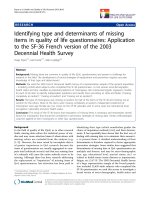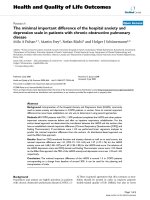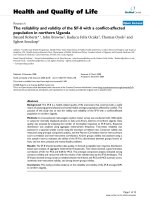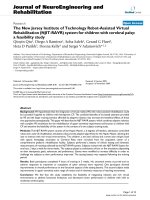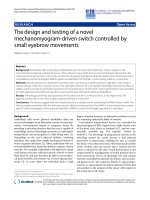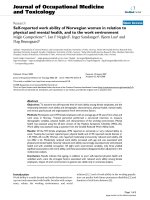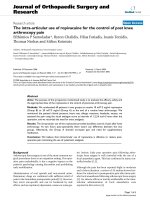báo cáo hóa học: " The fixed point theorems of 1-set-contractive operators in Banach space" docx
Bạn đang xem bản rút gọn của tài liệu. Xem và tải ngay bản đầy đủ của tài liệu tại đây (218.09 KB, 7 trang )
RESEA R C H Open Access
The fixed point theorems of 1-set-contractive
operators in Banach space
Shuang Wang
Correspondence:
School of Mathematical Sciences,
Yancheng Teachers University,
Yancheng, 224051, Jiangsu, PR
China
Abstract
In this paper, we obtain some new fixed point theorems and existence theorems of
solutions for the equation Ax = μx using prop erties of strictly convex (concave)
function and theories of topological degree. Our results and methods are different
from the corresponding ones announced by many others.
MSC: 47H09, 47H10
Keywords: 1-Set-contractive operator, Topological degree, Convex function, Concave
function, Fixed point theorems
1 Introduction
For convenience, we first recall the topological degree of 1-set-contractive fields due to
Petryshyn [1].
Let E be a real Bana ch space, p Î E, Ω be a bounded open subset of E. Suppose that
A
:
→
E
is a 1-set-contractive operator such that
||
(
I − A
)
x − p|| ≥ δ>0, ∀x ∈ ∂
In addition, if there exists a k-set-contractive operator
(
k < 1
)
W : D →
E
such that
||Ax − Wx|| ≤
δ
3
, ∀x ∈ ∂D
,
then (I-W)x ≠ p, ∀x Î ∂D, and so it is easy to see that deg(I - W, D, p)iswell
defined and independent of W. Therefore, we are led to define the topological degree
as follows:
deg
(
I − A, D, p
)
=deg
(
I − W, D, p
).
Without loss of generality, we set p = θ in the above definition.
Let
A
:
→
E
be a 1-set-contractive operator. A is said to be a semi-closed 1-set-
contractive operator, if I -A is closed operator (see [2]).
It should be noted that t his class of operators, as special cases, includes completely
continuous operators, strict set-contractive operators, condensing operators, semi-com-
pact 1-set-contractive operators and others (see [2]).
Petryshyn [1] and Nussbaum [3] first introduced the topological degree of 1-set-con-
tractiv e fields, studied its basic properties and obtained fixed poi nt theorems of 1-set-
contractive operators. Amann [4] and Nussbaum [5] have introduced the fixed point
Wang Fixed Point Theory and Applications 2011, 2011:15
/>© 2011 Wang; licensee Springer. This is an Open Access article distributed under the terms of the Creative Commons Attribution
License (http://cre ativecommons.org/licenses/by/2.0), which permits unrestricted use, distribution, and reproduction in any medium,
provided the original work is properly cited.
indices of k-set contractive operators (0 ≤ k < 1) and condensing operators to derive some
fixed point theorems. As a complement, Li [2] has defined the fixed point index of 1-set-
contractive operators and obtained some fixed point theorems of 1-set-contractive opera-
tors. Recently, Li [6] obtained some fixed point theorems for 1-set-contractive operators
and existence theorems of solutions for the equation Ax = μx. Very recently, Xu [7]
extended the results of Li [6] and obtained some fixed point theorems. In this paper, we
continue to investigate boundary conditions, under which the topological degree of 1-set
contractive fields, deg(I-A, Ω, p), is equal to unity or zero. Consequently, we obtain some
new fixed point theorems and existence theorems of solutions for the equation Ax = μx
using properties of strictly convex (concave) functions. Our results and methods are differ-
ent from the corresponding ones announced by many others (e.g., Li [6], Xu [7]).
We need the following concepts and lemmas for the proof of our main results.
Suppose tha t
A
:
→
E
is a semi-closed 1-set-contractive operator and θ ∉ (I -
A)∂Ω, then, by the standard method, we can easil y see that the topological degree has
the basic properties as follows:
(a) (Normalization) deg(I, Ω, p) = 1, when p Î Ω; deg(I, Ω, p) = 0, when p ∉ Ω;
(b) (Solution property) If deg(I - A, Ω, θ) ≠ 0, then A has at least one fixed point in
Ω.
(c) (Additivity) For every pair of disjoint open subsets Ω
1
, Ω
2
of Ω such that {x Î
Ω |(I - A)x =0}⊂ Ω
1
∪ Ω
2
, we have
deg
(
I − A, , θ
)
=deg
(
I − A,
1
, θ
)
+deg
(
I − A,
2
, θ
).
(d) (Homotopy invariance) Let
H
(
t, x
)
= H
t
(
x
)
: [0, 1] × →
E
be a continuous
operator such that
|
|x − H
t
(
x
)
|| ≥ δ>0, for
(
t, x
)
∈ [0, 1] × ∂
and the measure of non-compactness g(H([0, 1] × Q)) ≤ g(Q) for every
Q
⊂
. Then
deg(I - H
t
, Ω, θ)=const, for any t Î [0, 1].
(e) Let B be an open ball with center θ,
A
:
¯
B →
E
a semi-closed 1-set-contractive
operator and (I - A)x ≠ 0 for all x Î ∂B. Suppose that A is odd on ∂B (i.e., A(-x)=
Ax, for x Î ∂B), then deg(I - A, B, θ) ≠ 0.
(f) (Change of base) Let p ≠ θ, then deg(I - A, Ω , p) = deg(I - A - p, Ω, θ).
Lemm a 1.1. [7]. Let E be a real Banach space, Ω a bounded open subset of E and θ
Î Ω.
A
:
→
E
is a semi-closed 1-set-contractive operator and satisfies the Leray-
Schauder boundary condition
Ax = tx,
f
or all x ∈ ∂, and t ≥ 1
,
(L À S)
then deg(I - A, Ω, θ)=1and so A has a fixed point in Ω.
Definition 1.2.LetD beanonemptysubsetofR.If : D ® R is a real function
such that
ϕ[tx +
(
1 − t
)
y] < tϕ
(
x
)
+
(
1 − t
)
ϕ
(
y
)
, ∀x, y ∈ D, x = y, t ∈
(
0, 1
),
Wang Fixed Point Theory and Applications 2011, 2011:15
/>Page 2 of 7
then is called strictly convex function on D.If : D ® R is a real function such
that
ϕ[tx +
(
1 − t
)
y] > tϕ
(
x
)
+
(
1 − t
)
ϕ
(
y
)
, ∀x, y ∈ D, x = y, t ∈
(
0, 1
),
then is called strictly concave function on D.
2 Main results
We are now in the position to apply the topological degree and properties of strictly
convex (concave) function to derive some new fixed point theorems for semi-closed 1-
set-contractive operators and existence theorems of solutions for the equation Ax = μx
which generalize a great deal of well-known results and relevant recent ones.
Theorem 2.1. Let E, Ω, A be the same as in Lemma 1.1. Moreover, if there exist
strictly convex function : R
+
® R
+
with (0) = 0 and real function j : R
+
® R w ith
j (t) ≥ 1, for all t >1,such that
ϕ
(
||Ax − x||
)
≥ ϕ
(
||Ax||
)
φ
(
||Ax|| · ||x||
−1
)
− ϕ
(
||x||
)
, ∀x ∈ ∂
,
(1)
then deg(I - A, Ω, θ)=1if A has no fixed point on ∂Ω, and so A has at least one
fixed point in
.
Proof. If the operator A has a fixed point on ∂Ω,thenA has at least one fixed point
in
. Now suppose that A has no fixed points on ∂Ω.Nextweshallprovethatthe
condition (L-S) is satisfied.
Suppo se this is not true. Then there exists x
0
Î ∂Ω, t
0
≥ 1suchthatAx
0
= t
0
x
0
,i.e.,
x
0
= t
−1
0
Ax
0
. It is easy to see that ||Ax
0
|| ≠ 0 and t
0
>1.
From (1), we have
ϕ(||Ax
0
− t
−1
0
Ax
0
||) ≥ ϕ(||Ax
0
||)φ(||Ax
0
|| · ||t
−1
0
Ax
0
||
−1
) − ϕ(||t
−1
0
Ax
0
||)
,
which implies
ϕ[(1 − t
−1
0
)||Ax
0
||]+ϕ(t
−1
0
||Ax
0
||) ≥ ϕ(||Ax
0
||)φ(t
0
)
.
(2)
By strict convexity of and (0) = 0, we obtain
ϕ[(1 − t
−1
0
)||Ax
0
||]+ϕ(t
−1
0
||Ax
0
||)=ϕ[(1 − t
−1
0
)||Ax
0
|| + t
−1
0
||θ||]+ϕ[t
−1
0
||Ax
0
|| +(1− t
−1
0
)||θ||]
< (1 − t
−1
0
)ϕ(||Ax
0
||)+t
−1
0
ϕ(0) + t
−1
0
ϕ(||Ax
0
||)+(1− t
−1
0
)ϕ(0
)
= ϕ
(
||Ax
0
||
)
.
(3)
It is easy to see from (2) and (3) that
ϕ
(
||Ax
0
||
)
φ
(
t
0
)
<ϕ
(
||Ax
0
||
).
(4)
Noting that t
0
> 1 and j(t) ≥ 1, for all t > 1, we have
ϕ
(
||Ax
0
||
)
φ
(
t
0
)
≥ ϕ
(
||Ax
0
||
),
which contradicts (4), and so the condition (L-S) is satisfied. Therefore, it follows
from Lemma 1.1 that the conclusions of Theorem 2.1 hold. □
Remark 2.2. If there exist convex function : R
+
® R
+
, (0) = 0 and real function j
: R
+
® R, j (t)>1,∀t > 1 satisfied (1), the conclusions of Theorem 2.1 also hold.
Theorem 2.3. Let E, Ω, A be the same as in Lemma 1.1. Moreover, if there exist
strictly concave function : R
+
® R
+
with (0) = 0 and real function j : R
+
® R, j
(t) ≤ 1, ∀t >1,such that
Wang Fixed Point Theory and Applications 2011, 2011:15
/>Page 3 of 7
ϕ
(
||Ax − x||
)
≤ ϕ
(
||Ax||
)
φ
(
||Ax|| · ||x||
−1
)
− ϕ
(
||x||
)
, ∀x ∈ ∂
,
(5)
then deg(I - A, Ω, θ)=1if A has no fixed point on ∂Ω, and so A has at least one
fixed point in
.
Proof. If the operator A has a fixed point on ∂Ω,thenA has at least one fixed point
in
. Now suppose that A has no fixed points on ∂Ω.Nextweshallprovethatthe
condition (L-S) is satisfied.
Suppo se this is not true. Then there exists x
0
Î ∂Ω, t
0
≥ 1suchthatAx
0
= t
0
x
0
,i.e.,
x
0
= t
−1
0
Ax
0
. It is easy to see that ||Ax
0
|| ≠ 0 and t
0
> 1. From (5), we have
ϕ(||Ax
0
− t
−
1
0
Ax
0
||) ≤ ϕ(||Ax
0
||)φ(||Ax
0
|| · ||t
−
1
0
Ax
0
||
−1
) − ϕ(||t
−
1
0
Ax
0
||)
.
This implies that
ϕ[(1 − t
−
1
0
)||Ax
0
||]+ϕ(t
−
1
0
||Ax
0
||) ≤ ϕ(||Ax
0
||)φ(t
0
)
.
(6)
By strict concavity of and (0) = 0, we obtain
ϕ[(1 − t
−
1
0
)||Ax
0
||]+ϕ(t
−
1
0
||Ax
0
||)=ϕ[(1 − t
−
1
0
)||Ax
0
|| + t
−
1
0
||θ||]+ϕ[t
−
1
0
||Ax
0
|| +(1− t
−
1
0
)||θ||]
> (1 − t
−1
0
)ϕ(||Ax
0
||)+t
−1
0
ϕ(0) + t
−1
0
ϕ(||Ax
0
||)+(1− t
−1
0
)ϕ(0
)
= ϕ
(
||Ax
0
||
)
.
(7)
It follows from (6) and (7) that
ϕ
(
||Ax
0
||
)
φ
(
t
0
)
>ϕ
(
||Ax
0
||
).
(8)
On the other hand, by t
0
> 1 and j(t) ≤ 1, ∀t > 1, we have
ϕ
(
||Ax
0
||
)
φ
(
t
0
)
≤ ϕ
(
||Ax
0
||
),
which contradicts (8), and so the condition (L-S) is satisfied. Therefore, it follows
from Lemma 1.1 that the conclusions of Theorem 2.3 hold. □
Remark 2.4. If there exist concave function : R
+
® R
+
, (0) = 0 and real function
j : R
+
® R, j (t)<1,∀t > 1 satisfied (5), the conclusions of Theorem 2.3 also hold.
Corollary 2.5. Let E, Ω, A be the same as in Lemma 1.1. Moreover, if there exist a Î
(-∞,0)∪ (1, +∞) and b ≥ 0 such that
||
Ax − x
||
α
≥
||
Ax
||
α+β
||
x
||
−β
−
||
x
||
α
, ∀x ∈ ∂
,
then deg(I - A, Ω, θ)=1if A has no fixed point on ∂Ω, and so A has at least one
fixed point in
.
Proof.Putting(t)=t
a
, j(t)=t
b
,wehave (t) is a strictly convex function with
(0) = 0 and j(t) ≥ 1, ∀t > 1. Therefore, from Theorem 2.1, the conclusions of Corollary
2.5 hold □
Remark 2.6. 1. Corollary 2.5 generalizes Theorem 2.2 of Xu [7] from a >1toa Î
(-∞,0)∪ (1, +∞). Moreover, our methods are different from those in many recent
works (e.g., Li [6], Xu [7]).
2. Putting a >1,b = 0 in Corollary 2.5, we can obtain Theorem 5 of Li [6].
Corollary 2.7. Let E, Ω, A be the same as in Lemma 1.1. Moreover, if there exist a Î
(0, 1) and b ≤ 0 such that
||
Ax − x
||
α
≤
||
Ax
||
α+β
||
x
||
−β
−
||
x
||
α
, ∀x ∈ ∂D,
Wang Fixed Point Theory and Applications 2011, 2011:15
/>Page 4 of 7
then deg(I - A, Ω, θ)=1if A has no fixed point on ∂Ω, and so A has at least one
fixed point in
.
Proof.Putting(t )=t
a
, j(t)=t
b
,wehave(t) is a strictly concave function with
(0) = 0 and j(t) ≤ 1, ∀t > 1. Therefore, from Theorem 2.3, the conclusions of Corollary
2.7 hold. □
Remark 2.8. Corollary 2.7 extends Theorem 8 of Li [6]. Putting b = 0 in Corollary
2.7, we can obtain Theorem 8 of Li [6].
Theorem 2.9. Let E, Ω, A be the same as in Lemma 1.1. Moreover, if there exist
strictly convex function : R
+
® R
+
with (0) = 0 and real function j : R
+
® R w ith
j(t) ≥ 1, for all t >1,such that
ϕ
(
||Ax − x||
)
≥ ϕ
(
||Ax||
)
φ
(
||Ax + x|| · ||x||
−1
)
− ϕ
(
||x||
)
, ∀x ∈ ∂
,
(9)
then deg(I - A, Ω, θ)=1if A has no fixed point on ∂Ω, and so A has at least one
fixed point in
.
Proof. If the operator A has a fixed point on ∂Ω,thenA has at least one fixed point
in
. Now suppose that A has no fixed points on ∂Ω.Nextweshallprovethatthe
condition (L-S) is satisfied.
Suppo se this is not true. Then there exists x
0
Î ∂Ω, t
0
≥ 1suchthatAx
0
= t
0
x
0
,i.e.,
x
0
= t
−
1
0
Ax
0
. It is easy to see that ||Ax
0
|| ≠ 0 and t
0
> 1. By virtue of (9), we have
ϕ(||Ax
0
− t
−1
0
Ax
0
||) ≥ ϕ(||Ax
0
||)φ(||Ax
0
+ t
−1
0
Ax
0
|| · ||t
−1
0
Ax
0
||
−1
) − ϕ(||t
−1
0
Ax
0
||)
,
which implies
ϕ[(1 − t
−1
0
)||Ax
0
||]+ϕ(t
−1
0
||Ax
0
||) ≥ ϕ(||Ax
0
||)φ[(1 + t
−1
0
)t
0
]
.
(10)
By strict convexity of and (0) = 0, we obtain (3) holds. From (3) and (10), we
have
ϕ(||Ax
0
||)φ[(1 + t
−1
0
)t
0
] <ϕ(||Ax
0
||)
.
(11)
Noting that t
0
> 1 and j(t) ≥ 1, for all t > 1, we have
(1 + t
−1
0
)t
0
= t
0
+1>
1
, and so
ϕ(||Ax
0
||)φ[(1 + t
−1
0
)t
0
] ≥ ϕ(||Ax
0
||)
,
which contradicts (11), and so the condition (L-S) is satisfied. Therefore, it follows
from Lemma 1.1 that the conclusions of Theorem 2.9 hold. □
Remark 2.10. If there exist convex function : R
+
® R
+
, (0) = 0 and real function
j : R
+
® R, j(t)>1,∀t > 1 satisfied (9), the conclusions of Theorem 2.9 also hold.
Theorem 2.11. Let E, Ω, A be the same as in Lemma 1.1. Moreover, if there exist
strictly concave function : R
+
® R
+
with (0) = 0 and real function j : R
+
® R, j
(t) ≤ 1, ∀t >1,such that
ϕ
(
||Ax − x||
)
≤ ϕ
(
||Ax||
)
φ
(
||Ax + x|| · ||x||
−1
)
− ϕ
(
||x||
)
, ∀x ∈ ∂
,
(12)
then deg(I - A, Ω, θ)=1if A has no fixed point on ∂Ω, and so A has at least one
fixed point in
.
Proof. If the operator A has a fixed point on ∂Ω,thenA has at least one fixed point
in
. Now suppose that A has no fixed points on ∂Ω.Nextweshallprovethatthe
condition (L-S) is satisfied.
Wang Fixed Point Theory and Applications 2011, 2011:15
/>Page 5 of 7
Suppo se this is not true. Then there exists x
0
Î ∂Ω, t
0
≥ 1suchthatAx
0
= t
0
x
0
,i.e.,
x
0
= t
−
1
0
Ax
0
. It is easy to see that ||Ax
0
|| ≠ 0 and t
0
> 1. By (12), we have
ϕ(||Ax
0
− t
−
1
0
Ax
0
||) ≤ ϕ(||Ax
0
||)φ(||Ax
0
+ t
−
1
0
Ax
0
|| · ||t
−
1
0
Ax
0
||
−1
) − ϕ(||t
−
1
0
Ax
0
||)
,
which implies
ϕ[(1 − t
−1
0
)||Ax
0
||]+ϕ(t
−1
0
||Ax
0
||) ≤ ϕ(||Ax
0
||)φ[(1 + t
−1
0
)t
0
]
.
(13)
By strict concavity of and (0) = 0, we have (7) holds. From (7) and (13), we obtain
ϕ(||Ax
0
||)φ[(1 + t
−
1
0
)t
0
] >ϕ(||Ax
0
||)
.
(14)
On the ot her hand, by t
0
>1,wehave
(1 + t
−
1
0
)t
0
= t
0
+1>
1
. Therefore, it follows
from j(t) ≤ 1, ∀t > 1 that
ϕ(||Ax
0
||)φ[(1 + t
−1
0
)t
0
] ≤ ϕ(||Ax
0
||)
,
which contradicts (14), and so the condition (L-S) is satisfied. Therefore, it follows
from Lemma 1.1 that the conclusions of Theorem 2.11 hold. □
Remark 2.12. If there exist convex function : R
+
® R
+
, (0) = 0 and real function
j : R
+
® R, j (t)>1,∀t > 1 satisfied (12), the conclusions of Theorem 2.11 also hold.
Corollary 2.13. Let E, Ω, A be the same as in Lemma 1.1. Moreover, if there exist a
Î (-∞,0)∪(1, +∞) and b ≥ 0 such that
||
Ax − x
||
α
||
x
||
β
≥
||
Ax
||
α
||
Ax + x
||
β
−
||
x
||
α+β
, ∀x ∈ ∂
,
(15)
then deg(I - A, Ω, θ)=1if A has no fixed point on ∂Ω, and so A has at least one
fixed point in
.
Proof. From (15), we have
||
Ax − x
||
α
≥
||
Ax
||
α
||
Ax + x
||
β
||
x
||
−β
−
||
x
||
α
, ∀x ∈ ∂
.
Taking (t)=t
a
, j(t)=t
b
,wehave (t) is a strictly convex function with (0) = 0
and j(t) ≥ 1, ∀t > 1. Therefore, from Theorem 2.9, the conclusions of Corollary 2.13
hold. □
Remark 2.14. 1. Corollary 2.13 generalizes Theorem 2.4 of Xu [7] from a >1toa Î
(-∞,0)∪ (1, +∞). Moreover, our methods are different from those in many recent
works (e.g., Li [6], Xu [7]).
2. Putting a >1,b = 0 in Corollary 2.13, we can obtain Theorem 5 of Li [6].
Corollary 2.15. Let E, Ω, A be the same as in Lemma 1.1. Moreover, if there exist a
Î (0, 1) and b ≤ 0 such that
||
Ax − x
||
α
||
x
||
β
≤
||
Ax
||
α
||
Ax + x
||
β
−
||
x
||
α+β
, ∀x ∈ ∂
,
(16)
then deg(I - A, Ω, θ)=1if A has no fixed point on ∂Ω, and so A has at least one
fixed point in
.
Proof. From (16), we have
||
Ax − x
||
α
≤
||
Ax
||
α
||
Ax + x
||
β
||
x
||
−β
−
||
x
||
α
, ∀x ∈ ∂
.
Putting (t)=t
a
, j(t)=t
b
, we have (t) is a strictly concave function with (0) = 0
and j(t) ≤ 1, ∀t > 1. Therefore, from Theorem 2.11, the conclusions of Corollary 2.15
hold. □
Wang Fixed Point Theory and Applications 2011, 2011:15
/>Page 6 of 7
Remark 2.16. Corollary 2.15 extends Theorem 8 of Li [6]. Putting b = 0 in Corollary
2.15, we can obtain Theorem 8 of Li [6].
Theorem 2.17. Let E, Ω, A be the sa me as in Lemma 1.1. M oreover, if there exist a
Î (-∞,0)∪(1, +∞), b ≥ 0 and μ ≥ 1 such that
|
|Ax −
μ
x||
α
≥||Ax||
α+β
||
μ
x||
−β
−||
μ
x||
α
, ∀x ∈ ∂
,
then the equation Ax = μx possesses a solution in
.
Proof. Without loss of generality, suppose that
1
μ
A has no fixed point on ∂Ω.From
(17), we have
1
μ
α
||Ax − μx||
α
≥
1
μ
α
||Ax||
α+β
||μx||
−β
−
1
μ
α
||μx||
α
, ∀x ∈ ∂
,
which implies
|
|
1
μ
Ax − x||
α
≥||
1
μ
Ax||
α+β
||x||
−β
−||x||
α
, ∀x ∈ ∂
.
It is easy to see that
1
μ
A is a semi-closed 1-set-contractive operator. It follows from
Corollary 2.5 that
deg(I −
1
μ
A, , θ)=1=
0
, and so the equation Ax = μx possesses a
solution in
.
Remark 2.18. Similarly, from Corollary 2.7, Corollary 2.13 or Corollary 2.15, we can
obtain the equation Ax = μx possesses a solution in
.
Acknowledgements
This study was supported by the Natural Science Foundation of Yancheng Teachers University under Grant
(10YCKL022).
Competing interests
The authors declare that they have no competing interests.
Received: 14 November 2010 Accepted: 19 July 2011 Published: 19 July 2011
References
1. Petryshyn, WV: Remark on condensing and k-set-contractive mappings. J. Math. Anal. Appl. 39, 717–741 (1972).
doi:10.1016/0022-247X(72)90194-1
2. Li, GZ: The fixed point index and the fixed point theorems for 1- set-contraction mappings. Proc. Am. Math. Soc. 104,
1163–1170 (1988)
3. Nussbaum, RD: Degree theory for local condensing maps. J. Math. Anal. Appl. 37, 741–766 (1972). doi:10.1016/0022-
247X(72)90253-3
4. Amann, H: Fixed point equations and nonlinear eigenvalue problems in ordered Banach space. SIAM Rev. 18, 620–709
(1976). doi:10.1137/1018114
5. Nussbaum, RD: The fixed index and asymptotic fixed point theorems for k-set-contractions. Bull. Am. Math. Soc. 75,
490–495 (1969). doi:10.1090/S0002-9904-1969-12213-5
6. Li, GZ, Xu, SY, Duan, HG: Fixed point theorems for 1-set-contractive operators in Banach spaces. Appl. Math. Lett. 19,
403–412 (2006). doi:10.1016/j.aml.2005.02.035
7. Xu, SY: New fixed point theorems for 1-set-contractive operators in Banach spaces. Nonlinear Anal. 67, 938–944 (2007).
doi:10.1016/j.na.2006.06.051
doi:10.1186/1687-1812-2011-15
Cite this article as: Wang: The fixed point theorems of 1-set-contractive operators in Banach space. Fixed Point
Theory and Applications 2011 2011:15.
Wang Fixed Point Theory and Applications 2011, 2011:15
/>Page 7 of 7
